Sometimes it seems like every project goes over time and budget. Here are three tips to help you keep costs and programme under control.
Avoid rework
There are many professionals and contractors involved in land development. This is especially true during the design process. Getting it right the first time is so important. You can do this in two ways.
- Get good site data. This will remove assumptions and the associated risks.
- Understand the construction methodology. This will ensure that work is coordinated and reduces the chance of key tasks being overlooked.
Over-communicate
Don’t assume that anyone knows what to do or how to do it. While many professionals have excellent technical skills, many won’t share your vision. Unfortunately the predominant land development model does not align incentives. If you’re paying for hours, that’s what you’ll get.
Key documents that should be shared again and again throughout the project team are:
- Briefs and a scopes
- Consent conditions
- Plans and specifications
- The programme
- Inspections and sign-offs
Most importantly, ask questions. Land development involves at least five different disciplines (surveying, civil engineering, geotechnical engineering, planning, urban design/landscape architecture). Each one has its own extensive body of knowledge. The opportunities to learn (and mis-communicate) are virtually endless.
Focus on compliance
The use of land is heavily regulated to control effects on the environment. Taking a compliance focus keeps outputs aligned with outcomes. Box ticking is important. By identifying what information is needed as early as possible and providing it, there’s less need to respond to requests for further information.
Summary
Rework, poor communication and compliance are common land development issues. Use these tips to help overcome some common roadblocks in the process.




